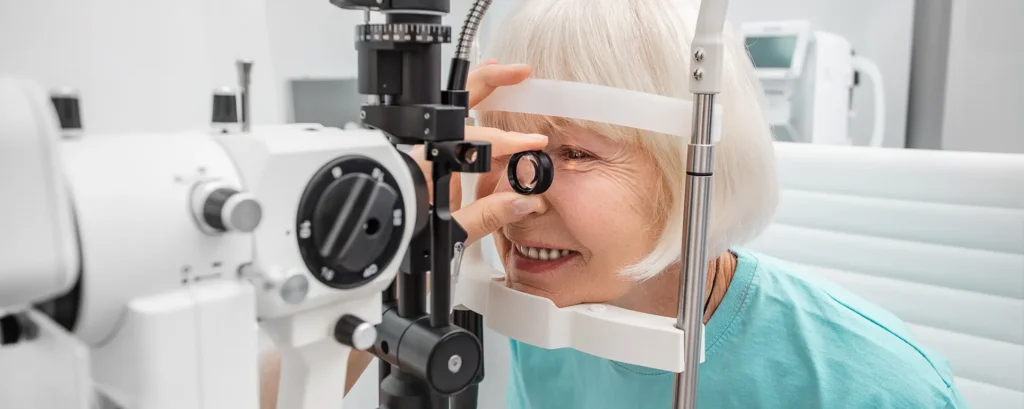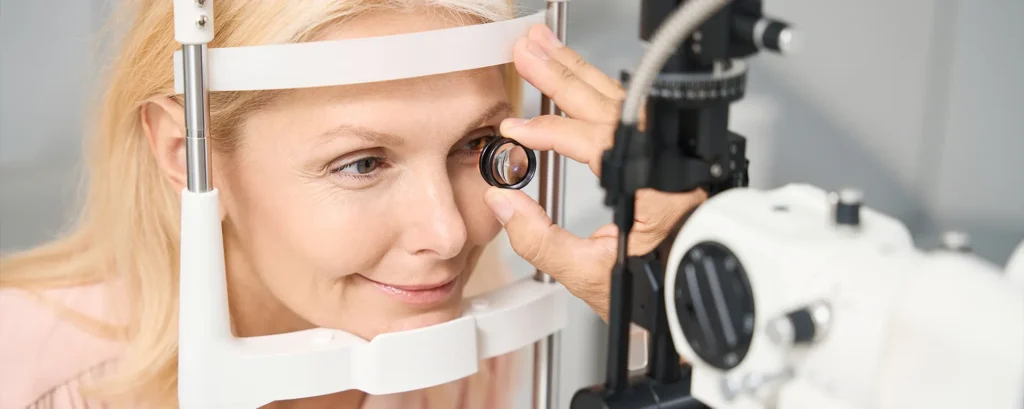If you are preparing for cataract surgery, one of the most important choices you will face is which intraocular lens, or IOL, will replace your clouded natural lens. While there are advanced options such as trifocal or extended depth of focus lenses, the vast majority of people still choose a monofocal lens. These lenses have stood the test of time, offering excellent clarity at one set distance, usually for distance vision.
The tricky part is that not all monofocal lenses are the same. Over the years, manufacturers have developed new designs and materials to improve performance. This is why when you sit down with your surgeon, you may hear names like Alcon AcrySof IQ, Zeiss CT ASPHINA, or Johnson & Johnson Tecnis Eyhance. At first, these names might feel overwhelming, but each lens has its own advantages that could make a real difference to your quality of vision after surgery.
This article takes you through the leading monofocal IOL brands available today. You will see what makes them different, how they compare, and why one might suit your needs better than another. By the end, you should feel much more confident about the questions to ask your surgeon before making your final decision.
Why Monofocal Lenses Are Still the Standard Choice
Despite the growing popularity of multifocal and premium lenses, monofocal lenses continue to be the most widely used type worldwide. There are several reasons why they remain the standard option.
Proven results
Monofocal lenses have been used for decades. Millions of people around the world have had them implanted, and the long-term safety record is excellent. Medical studies show consistently strong outcomes, making them a dependable choice. For people who prefer a solution that is well-tested and reliable, monofocals are often the most reassuring option.
Sharp visual quality
Because they focus at one single distance, monofocal lenses are designed for crisp, clear vision. Most patients choose to set that focus at distance, which means everyday activities like driving, watching TV, or going for a walk are sharp and clear. Glasses are usually still needed for reading or detailed close-up tasks, but the distance clarity is excellent.
Fewer visual side effects
One of the challenges with multifocal or trifocal lenses is that they can sometimes cause unwanted side effects such as halos, glare, or reduced contrast sensitivity. With monofocals, the risk of these side effects is much lower, which makes them particularly appealing to people who drive at night or work in low-light conditions.
Cost considerations
Monofocal IOLs are generally the most affordable type of lens. For patients who are conscious of cost, they provide a very effective solution without the higher price tag that often comes with premium lenses. This accessibility has helped keep them the most widely used option.
Key Monofocal Lens Brands to Know

Let’s take a closer look at the most recognised monofocal lens brands on the market today. Each one has been designed with slightly different priorities in mind, and your surgeon may recommend one over another depending on your eye health, lifestyle, and expectations.
Alcon AcrySof IQ
The AcrySof IQ is one of the most widely implanted monofocal lenses worldwide. It uses a hydrophobic acrylic material that resists clouding and has been shown to reduce the risk of posterior capsule opacification, which is a common long-term complication after cataract surgery. Its aspheric design helps improve contrast sensitivity and reduces glare, especially at night.
Another strength of the AcrySof IQ is its stability inside the eye. The lens design helps it stay securely centred, which is crucial for consistent vision quality. Many surgeons trust it because of its reliability and long track record.
For patients, this lens offers sharp distance vision, excellent stability, and a low rate of complications. It is often considered a safe, dependable choice for people who want predictable results.
Zeiss CT ASPHINA
Zeiss is well known in optics, and their CT ASPHINA lens reflects that reputation. It is a single-piece aspheric lens made from a hydrophilic acrylic material with a hydrophobic surface. This combination helps balance comfort, clarity, and long-term performance.
The CT ASPHINA is designed to reduce spherical aberrations, which improves visual quality in different lighting conditions. Patients who choose this lens often report high levels of satisfaction with both daytime and night-time vision.
A particular strength of the Zeiss CT ASPHINA is its optical quality. Zeiss has decades of expertise in producing high-quality optics, and this lens benefits from that heritage. Surgeons often recommend it for patients who value precision and visual sharpness.
Johnson & Johnson Tecnis Eyhance
The Tecnis Eyhance is a newer generation of monofocal lens. It is designed to go beyond traditional monofocals by providing not only sharp distance vision but also slightly better intermediate vision compared to standard designs. This means it can make tasks like using a computer or reading your phone more comfortable without always needing glasses.
The lens is made from a hydrophobic acrylic material that is resistant to clouding and deposits. It also includes an aspheric design to enhance contrast sensitivity and reduce glare. Many surgeons describe it as a “next-level” monofocal because it gives a small amount of extra flexibility without introducing the side effects sometimes seen with multifocal lenses.
Patients who want the safety and simplicity of a monofocal but hope for just a little more range in their vision often find this lens appealing.
Other Notable Monofocal Lenses
While the three brands above are among the most widely used, there are other strong contenders worth knowing about.
- Bausch + Lomb enVista: This hydrophobic acrylic lens is designed with a square-edge profile to minimise the risk of posterior capsule opacification. It is known for its optical clarity and stability.
- Rayner C-flex and Superflex: Rayner is a UK-based company and has a long history in IOL development. Their C-flex and Superflex monofocals are valued for their high quality and are used in many clinics across Europe.
What to Think About When Choosing a Monofocal Lens

Your lifestyle needs
Think carefully about your daily activities. If you drive a lot, especially at night, you may want a lens with excellent contrast sensitivity and minimal glare. If you spend hours on the computer, a lens like the Tecnis Eyhance, which provides slightly more intermediate vision, might be useful.
Your eye health
Certain conditions, such as astigmatism or retinal disease, can influence which lens will be most suitable. Your surgeon will guide you through these considerations, but it helps to be aware that not every lens works equally well for every eye.
Long-term safety
All the major lens brands mentioned have strong safety profiles, but some materials and coatings are slightly better at reducing the chance of long-term issues like clouding of the capsule. Discuss this with your surgeon to see which option offers the lowest risk for you.
Cost and availability
Depending on where you have your surgery, certain lenses may be more commonly stocked than others. Costs can also vary. It is always a good idea to ask which lenses your clinic offers and whether there is an additional fee for a specific brand.
FAQs
1. Which monofocal lens brand is most commonly used worldwide?
The Alcon AcrySof IQ is widely regarded as the most commonly used monofocal lens globally. Surgeons have trusted it for decades, and its track record is backed by millions of successful implants across different countries. One of the reasons for its popularity is the hydrophobic acrylic material, which has shown excellent resistance to clouding and long-term complications. Patients who receive this lens often benefit from sharp, predictable distance vision.
Another key feature that drives its global use is stability. The design of the haptics — the tiny arms that hold the lens in place inside the eye — ensures that the AcrySof IQ stays well-centred, which is crucial for visual quality. When a lens shifts even slightly off-centre, it can affect clarity, but this is rarely an issue with AcrySof designs. This reliability makes it a safe bet for both surgeons and patients.
In addition, Alcon has invested heavily in clinical trials and real-world studies, which means surgeons have a large amount of evidence to draw on when recommending this lens. For patients, this translates to peace of mind: when you choose a lens with a proven history, you can feel confident about the outcome.
2. What makes the Zeiss CT ASPHINA different from other monofocal lenses?
The Zeiss CT ASPHINA sets itself apart because of its optical engineering. Zeiss has a long history in producing high-quality optics — think of their microscopes, camera lenses, and medical imaging systems. This expertise carries through into their IOL designs, where precision is everything. The CT ASPHINA reduces spherical aberrations, meaning that light entering the eye is focused more precisely, resulting in sharper and clearer vision.
Another difference lies in its material. The lens is made from a hydrophilic acrylic core with a hydrophobic surface treatment, combining the benefits of comfort and clarity with long-term resistance to clouding. Many patients report particularly clear night-time vision with this lens, which is important for those who drive regularly in darker conditions.
Surgeons often recommend Zeiss CT ASPHINA to patients who want the highest optical precision and who may be sensitive to visual distortions. Its reputation for delivering consistent sharpness makes it a strong competitor to Alcon’s AcrySof IQ, especially for patients who prioritise night-time vision and contrast sensitivity.
3. How does the Johnson & Johnson Tecnis Eyhance compare with a standard monofocal?
The Johnson & Johnson Tecnis Eyhance is often described as a “next-generation” monofocal lens because it offers more than just distance clarity. Unlike a traditional monofocal, which focuses sharply at one distance only, the Tecnis Eyhance is designed to provide slightly better intermediate vision. This means patients may find everyday activities such as using a smartphone, working at a computer, or reading a menu more comfortable without glasses.
The Tecnis Eyhance achieves this through a modified aspheric profile. Essentially, the central zone of the lens is optimised for distance vision, while the gradual change in curvature towards the edge extends the depth of focus slightly. This is not enough to replace reading glasses completely, but it is enough to give patients a little more visual freedom.
Patients who want the reassurance of a monofocal but are interested in reducing their dependency on glasses for intermediate tasks often find this lens appealing. Surgeons see it as a middle ground between a traditional monofocal and premium multifocal lenses, providing flexibility without the higher risk of halos or glare that come with trifocals.
4. Which monofocal lens is best if I want to minimise glare and halos?
All monofocal lenses tend to have a lower risk of halos and glare compared to multifocal or trifocal designs, but some brands are particularly noted for reducing these effects. The Alcon AcrySof IQ, for example, has an aspheric design that improves contrast sensitivity and reduces optical imperfections, making it a reliable option for patients who drive at night.
The Zeiss CT ASPHINA is also often recommended for patients who are sensitive to glare. Its precise optical engineering helps reduce spherical aberrations, which can contribute to night-time visual disturbances. Patients who have chosen this lens frequently report stable and clear vision under challenging lighting conditions.
The Tecnis Eyhance, while slightly different in design, is also engineered to limit glare and halos. Johnson & Johnson has focused on making sure that the extra intermediate range does not come at the cost of unwanted side effects. For patients who want a balance between flexibility and clarity, this makes it a strong option.
5. Is the Tecnis Eyhance considered a premium monofocal?
Yes, the Tecnis Eyhance is often referred to as a premium monofocal because it offers more than the standard distance-only focus. It does not cross into multifocal or trifocal territory, but it provides a small extension of focus that makes everyday life easier for patients who don’t want to rely on glasses for every intermediate task.
The premium label comes not just from its performance but also from its design. The material is hydrophobic acrylic, which helps prevent clouding over time, and the aspheric profile is carefully calculated to provide enhanced optical outcomes. Compared to older monofocal models, this design represents a clear advancement.
Patients often find the Tecnis Eyhance attractive because it blends the best of both worlds: the reliability and simplicity of a monofocal with just a bit more versatility. For people who do not want the trade-offs of trifocal lenses, it’s a premium but safe choice.
6. Which brand has the longest safety record?
The Alcon AcrySof family of lenses has one of the longest and strongest safety records in cataract surgery. Introduced decades ago, it has been implanted in tens of millions of eyes worldwide. This history means surgeons can draw on a vast amount of clinical data showing its durability, optical clarity, and low complication rates.
The hydrophobic acrylic material used in AcrySof lenses has been a major factor in this track record. It is resistant to opacification and has helped reduce the rates of posterior capsule opacification compared to older materials. This is why it remains a go-to choice for many surgeons globally.
For patients, the reassurance of such a long-standing record is invaluable. When a lens has been studied and used so extensively, it provides peace of mind that the outcomes are both reliable and predictable.
7. How do the Zeiss CT ASPHINA lenses compare with Tecnis Eyhance for everyday tasks?
The Zeiss CT ASPHINA excels in delivering pure, sharp distance vision. Patients often notice its strength most when driving at night or in dimly lit environments, where contrast sensitivity makes a big difference. For someone whose lifestyle involves frequent driving or outdoor activities, the CT ASPHINA is a very strong option.
On the other hand, the Tecnis Eyhance offers something slightly different. While its distance vision is also excellent, its design gives patients more comfort for intermediate tasks such as using a computer, shopping, or glancing at a phone. This makes it particularly useful for people who want a bit more range without committing to a multifocal lens.
Ultimately, both lenses are excellent, but the choice comes down to lifestyle. If you are more concerned with driving at night or achieving the sharpest possible distance vision, the Zeiss CT ASPHINA may be the better choice. If you want more flexibility for daily tasks, the Tecnis Eyhance might suit you better.
8. Are there toric versions of these monofocal lenses for astigmatism?
Yes, toric versions of all the major monofocal lenses are available, including the Alcon AcrySof IQ, Zeiss CT ASPHINA, and Johnson & Johnson Tecnis Eyhance. A toric lens is designed to correct astigmatism, which occurs when the cornea has an irregular shape. By correcting this, the lens can provide clear, sharp distance vision without the need for glasses.
The Alcon AcrySof IQ Toric is particularly well known and has been used extensively. It offers the same reliability as the standard AcrySof, with the added benefit of astigmatism correction. The Zeiss CT ASPHINA Toric also delivers precision optics with the same stability and clarity found in the non-toric model.
The Tecnis Eyhance Toric gives patients not only distance clarity and astigmatism correction but also that slight boost in intermediate vision. This combination is attractive for patients who want a little extra flexibility while still correcting their corneal irregularities.
9. How do Bausch + Lomb and Rayner lenses compare with the bigger names?
Bausch + Lomb enVista lenses are well respected for their clarity and edge design, which help reduce posterior capsule opacification. They are a strong alternative to Alcon, Zeiss, and Johnson & Johnson, especially in markets where they are more readily available. Patients often find them comfortable and reliable, and surgeons value their consistency.
Rayner, a UK-based manufacturer, also has an important place in the lens market. Their C-flex and Superflex monofocals are widely used across Europe and have built a reputation for quality. Surgeons appreciate their ease of implantation and stable results, and patients benefit from clear distance vision.
While these lenses may not be as widely recognised as Alcon, Zeiss, or Johnson & Johnson globally, they remain excellent choices. For patients in the UK and Europe in particular, Rayner lenses can be a very strong contender.
10. Which monofocal lens is best if I only want the most reliable, no-frills option?
If you are looking for the most reliable, straightforward option, the Alcon AcrySof IQ is often recommended. Its long history, millions of successful implants, and proven safety record make it a safe choice for patients who simply want predictable, clear distance vision.
That said, the Zeiss CT ASPHINA also deserves recognition for its optical sharpness and night-time clarity. If your lifestyle involves driving frequently or you want the sharpest optics possible, this lens could be a better fit.
For those who want reliability but also a touch of extra versatility, the Tecnis Eyhance is worth considering. It offers the dependability of a monofocal but with slightly improved intermediate range, making it easier to manage everyday tasks.
Final Thoughts
Monofocal lenses continue to be the most popular and trusted choice in cataract surgery. Brands like Alcon AcrySof IQ, Zeiss CT ASPHINA, and Johnson & Johnson Tecnis Eyhance each have their strengths, from long-term reliability to enhanced optical performance and even a bit of extra flexibility for intermediate vision.
The best choice for you will depend on your lifestyle, your eye health, and your expectations for life after surgery. By understanding the differences between these lenses, you can have a more informed discussion with your surgeon and feel confident about the decision you make.

